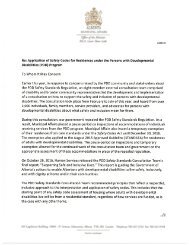In This Issue
click
click
You also want an ePaper? Increase the reach of your titles
YUMPU automatically turns print PDFs into web optimized ePapers that Google loves.
can be learned by students at all levels.<br />
It will allow you to identify where your<br />
client is in relation to readiness for<br />
change. Identifying the stage of change<br />
your client is in is invaluable, as it will<br />
allow you and your client to select<br />
interventions that are compatible with<br />
that particular stage of change. Another<br />
instrumental aspect of this model is that<br />
you can teach it to your clients, so they<br />
can become empowered in their own<br />
treatment! Once you become familiar<br />
with this model, you will use it during<br />
your entire field placement experience<br />
and throughout your professional<br />
career.<br />
<strong>This</strong> framework will allow<br />
you to meet clients where they are,<br />
thus empowering them. It will also<br />
encourage you to work from a strengths<br />
perspective. <strong>In</strong> addition, it will permit<br />
you to honor the clients’ autonomy<br />
by allowing clients to move toward<br />
positive change at their own pace.<br />
Finally, it will deter you from feeling<br />
responsible for your clients’ failures and<br />
successes.<br />
Overview of the Stages of<br />
Change Model<br />
• During the Pre-Contemplation stage<br />
of change, individuals have no<br />
intention to change, because they<br />
are not aware that they have a<br />
problem.<br />
• During the Contemplation stage of<br />
change, individuals are aware of<br />
their problem and are thinking<br />
about ceasing the behaviors that<br />
have caused the problem, but they<br />
are not yet fully dedicated to taking<br />
action. <strong>In</strong>dividuals can dwell in the<br />
contemplation stage of change for<br />
long periods of time.<br />
• The Preparation stage of change<br />
marks the beginning of “small”<br />
changes that indicate the<br />
individual’s desire to change<br />
behaviors that have led to<br />
identified problems.<br />
• The Action stage of change is<br />
defined by behavior, experiential,<br />
and environmental modification.<br />
The individual is ready to change<br />
those aspect(s) of life that are<br />
contributing to the undesired<br />
situation or problem.<br />
• <strong>In</strong> the Maintenance stage of change,<br />
individuals carry out adaptive<br />
behaviors that can help strengthen<br />
their resolve. An individual can<br />
stay in this stage an entire lifetime<br />
if dedicated to maintaining change.<br />
• During Relapse, individuals revert<br />
to earlier stages. It is imperative to<br />
let individuals know that “relapse”<br />
is part of recovery and that it is<br />
a simple bump in the road that<br />
can be overcome with hard work<br />
(Prochaska & DiClemente, 1982).<br />
Students! It is vital to understand<br />
that a “relapse” episode is not a<br />
reflection of your skills or of something<br />
you did or didn’t do. Relapse is a<br />
normal part of the change process.<br />
When a relapse or setback occurs<br />
during treatment, encourage your<br />
clients to get back up and “dust<br />
themselves off” and try again and again<br />
and again!<br />
The New Social Worker Winter 2017 7




